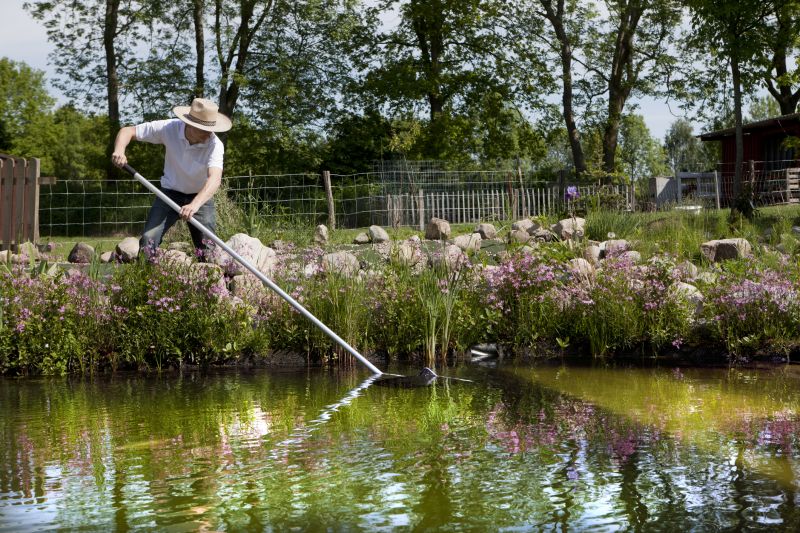Expert Picks of Top Products for Pond Soil Erosion Control and Prevention
Explore trusted products that help manage pond soil erosion efficiently, maintaining pond integrity and reducing sediment loss.
 Managing soil erosion in ponds is essential for maintaining water quality and structural stability. Erosion can lead to increased sedimentation, which affects aquatic life and can complicate pond maintenance. A variety of products are available to help control soil displacement, ranging from physical barriers to biological solutions. Proper selection depends on pond size, flow rate, and specific erosion challenges.
Managing soil erosion in ponds is essential for maintaining water quality and structural stability. Erosion can lead to increased sedimentation, which affects aquatic life and can complicate pond maintenance. A variety of products are available to help control soil displacement, ranging from physical barriers to biological solutions. Proper selection depends on pond size, flow rate, and specific erosion challenges.
Top Overall Option
Erosion Control Mat
Erosion control mats are versatile, durable solutions that help stabilize pond banks and prevent soil displacement. They are typically made from biodegradable or synthetic materials, providing immediate support while allowing vegetation to establish. Proper installation ensures they effectively reduce erosion and promote natural plant growth, making them a popular choice for pond management.
Types of Products For Pond Soil Erosion Managements
Erosion Control Mats
Matting materials designed to hold soil in place and support vegetation growth on pond banks.
Geotextile Fabrics
Permeable fabrics used to reinforce soil and prevent erosion in high-flow areas.
Bioengineering Plantings
Native grasses and shrubs planted to naturally stabilize soil and reduce runoff.
Live Stakes
Cuttings of woody plants inserted into the soil to promote root growth and bank stabilization.
Riprap Stones
Large rocks placed along shorelines to absorb wave energy and prevent soil erosion.
Silt Fences
Barrier fabrics installed to trap sediment and control runoff during construction or repair.
Gabion Baskets
Wire cages filled with stones used to reinforce pond edges and reduce erosion.
Vegetative Cover Crops
Fast-growing plants that establish quickly to shield soil from erosive forces.
Erosion Control Blankets
Textile blankets that protect soil surfaces from raindrop impact and runoff.
Flow Diversion Structures
Constructed features that redirect water flow to reduce pressure on vulnerable banks.
Popular Choices
Widely used for pond bank stabilization, these fabrics provide reinforcement and filtration.
Popular for natural stabilization, these seed mixes promote quick establishment of protective vegetation.
Commonly applied along shorelines, riprap stones help dissipate wave energy and reduce soil displacement.
These mats support plant growth while degrading over time, reducing long-term maintenance needs.
Flexible and effective, gabions are often used to reinforce pond edges and prevent erosion.
Natural root structures that help anchor soil and stabilize banks when installed properly.
Affordable and easy to install, silt fences are common for controlling sediment runoff.
Plant cuttings that quickly establish roots and help secure soil on pond banks.
Devices designed to manage water flow and reduce erosive forces on pond edges.
Protective coverings that shield soil from erosive elements while supporting vegetation growth.
Physical erosion control products such as erosion control mats and geotextile fabrics are commonly used to stabilize pond banks. These materials are designed to hold soil in place, especially in areas prone to heavy runoff or wave action. When installed correctly, they can significantly reduce soil loss and promote vegetation growth.
In addition to physical barriers, bioengineering solutions like live staking and planting native grasses can reinforce pond banks naturally. These methods not only prevent erosion but also enhance the habitat around the pond. Combining physical and biological approaches often yields the most effective long-term results.
Maintenance and monitoring are key components of erosion management. Regular inspections can identify early signs of soil displacement, allowing for timely intervention. Choosing the right products and techniques tailored to your pond's specific conditions will help sustain its integrity and prevent costly repairs in the future.
Key Buying Considerations
- Pond size and shape influence the choice of erosion control products needed.
- Flow rate and water movement patterns should be assessed to select appropriate stabilization methods.
- Soil type and composition impact how well certain products will adhere and perform.
- Climate conditions, including rainfall and temperature, can affect product longevity and effectiveness.
- Ease of installation and maintenance requirements are important for long-term success.
- Compatibility of materials with existing pond features and landscape design should be considered.
- Budget constraints may influence the selection of more cost-effective or durable options.
- The level of erosion severity can determine whether physical barriers or biological solutions are more suitable.
- Availability of local resources and expertise can impact product choice and installation methods.
- Long-term stability and growth potential should be evaluated to ensure sustainable erosion management.
- Environmental impact, including potential effects on aquatic life, may guide product selection.
- Legal or regulatory requirements in your area might specify certain erosion control standards.
- Monitoring and inspection routines are essential to assess the ongoing effectiveness of chosen products.
- Compatibility with pond maintenance activities, such as dredging or landscaping, should be considered.
- Durability against weather elements and UV exposure can influence product lifespan.
This content includes affiliate links. Purchasing through these links may earn a commission at no additional cost to you.
